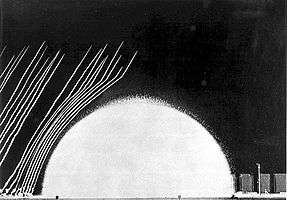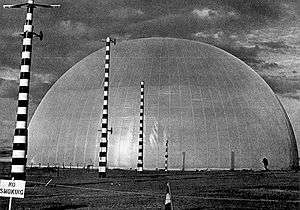Operation Distant Plain
| Operation Distant Plain | |
|---|---|
|
125 foot 20-short-ton (18 t) propane-oxygen hemisphere is prepared for detonation as Event 2A. The striped poles carry instrumentation equipment and a human figure can be seen in the lower right. | |
| Information | |
| Country | Canada |
| Test site |
|
| Date | July 7, 1966 – August, 1967 |
| Number of tests | 8 |
| Agency | Defence Research Board, TTCP |
| Explosive | TNT, Detonable Gas |
| Configuration |
|
| Max. yield | 100 tons of TNT (420 GJ) |
| Test chronology | |
Operation Distant Plain was a series of non-nuclear explosive and detonable gas tests performed on test sites in Alberta, Canada during the course of 1966 and 1967. Their purpose was to provide airblast, cratering and ground shock data in summer and winter conditions for testing new prototype equipment, military targets and coniferous forest blowdown and defoliation. Participants included Canada, United Kingdom, Australia and United States under the Tripartite Technical Cooperation Program.[1] Detonable gas balloons were used in this operation in an attempt to find an economical substitute for TNT as well as for the fact that they could be placed at desired heights without a heavy support structure or towers. In addition, they were more adaptable to airblast phenomena and produced a well defined blast wave without perturbation or ejecta; they also produced no crater. However, it was found that they lacked the high pressure associated with high explosives, and difficulties were encountered as the 20-ton gas balloon ruptured and another detonated unexpectedly during inflation. Ultimately ANFO was elected as a lower cost alternative to TNT for non-nuclear explosives tests.[2][3]
Tests
The following table summarizes the events that took place during the operation in chronological order.
| Event | Date | Charge | Yield (short tons) | Height of Burst (feet) | Location | Notes |
|---|---|---|---|---|---|---|
| 1 | 7 July, 1966 | TNT Sphere, Tower | 20 | 85 | Drowning Ford Test Range, SES | Airblast and induced ground motions |
| 2 | July, 1966 | 125 foot methane-oxygen balloon | 20 | 85 | Drowning Ford Test Range, SES | Cancelled, balloon ruptured during inflation |
| 2A | 22 July, 1966 | 125 foot propane-oxygen hemisphere | 20 | 0 | Drowning Ford Test Range, SES | Test feasibility of detonable gas, compare with 20 ton TNT events |
| 3 | 27 July, 1966 | TNT Sphere, half buried | 20 | 0 | Drowning Ford Test Range, SES | Normal environment control for Event 5 |
| 4 | 16 August, 1966 | TNT Hemisphere | 50 | 0 | Edson Forest, 10 miles northwest of Hinton | Coniferous forest blowdown test |
| 2B | October, 1966 | 125 foot methane-oxygen balloon | 18.6 | 63 | Drowning Ford Test Range, SES | Rescheduled Event 2, detonated unexpectedly during inflation on ground |
| 5 | 9 February, 1967 | TNT Sphere, half buried | 20 | 0 | Drowning Ford Test Range, SES | Frozen ground test |
| 6 | 26 July, 1967 | TNT Sphere, supported | 100 | 0 | Watchdog Hill Blast Range, SES | Nuclear weapon surface burst simulation |
| 1A | 18 August, 1967 | TNT Sphere, Tower | 20 | 30 | Watchdog Hill Blast Range, SES | Airblast and induced ground motions, repeat of event 1 |
 Detonation of 20 tons of propane-oxygen hemisphere in Event 2A. The blast wave can be seen affecting the smoke trails.
Detonation of 20 tons of propane-oxygen hemisphere in Event 2A. The blast wave can be seen affecting the smoke trails.
References
- ↑ Kelso, J. R.; Kingery., C. N.; Choromokos, J. Jr. (1 January 1966). "Operation Distant Plain. United States Participation With Canada, Australia, And Great Britain In a Non-Nuclear Experimental Test Series". Defence Technical Information Center. Retrieved 19 May 2017.
- ↑ Ingram, James K. (1 May 1971). "Operation Distant Plain, Events 1, 2A, 3, 4, and 5: Project 3.02A, Earth Motion and Stress Measurements". Defence Technical Information Center. Retrieved 19 May 2017.
- ↑ Ralph E., Reisler; Noel H., Ethridge; Daniel P., LeFevre; Louis, Giglio-Tos (1 July 1971). "Air Blast Measurements from the Detonation of an Explosive Gas Contained in a Hemispherical Balloon (Operation Distant Plain, Event 2a)". Retrieved 19 May 2017.
